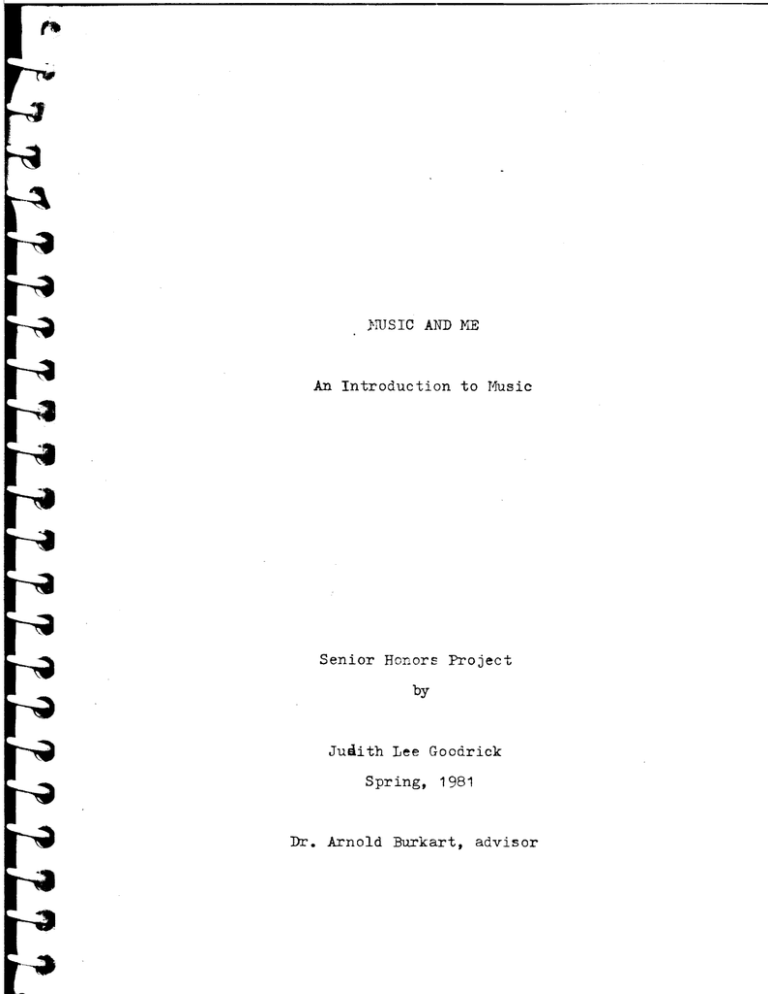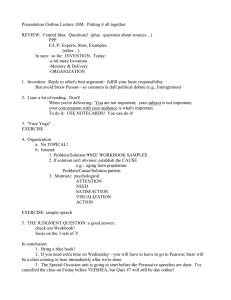An
advertisement

NUSIC AND ME
An Introduction to Husic
Senior Honors Project
by
Juaith Lee Goodrick
Spring, 1981
Dr. Arnold Burkart, advisor
,
;&
,
,
t
From Karch 11 to May 21 I did my student teaching at
LaSalle elementary school in Mishawaka, Indiana, under r'1rs. Erma
Gassensmith.
Although my prime objective was teaching math to
the fifth and sixth graders, I did have 45 minutes a day to work
with my homeroom of 25 fifth graders on spelling, music and art.
Due to a lack of funds, there is no music and/or art
teacher at LaSalle.
The
ele~entary
orcbestra
d~rector
co~es
once
For the rest of the students, music training is the home-
room teacher's responsibility.
sorely neglected.
Unfortunately it is a responsibility
There seems to be no problem with teaching an
art lesson, but music has been virtually ignored for many of the
students.
Because of my music endorsement, I was glad for the
opportunity to "enlighten" these children.
In addition to the varied musical background of my class,
I had to consider my time allotment.
While 45 minutes a day
sounds quite adequate, there had to be time set aside for spelling,
in the form of lesson introduction, pretest.and final test.
An-
other problem was the varying arrival and departure times of the
students.
The special reading students reach
hom~room
learning disabled students and patrols leave early.
teach anything in that last
fort.
late, the
Trying to
45 minutes takes a great deal of ef-
I knew 1 had to generate interest.
I realized that trying
,to cover even the rudiments of music such as pulse, rhythm, etc.
would be difficult.
Fortunately,
I~s.
Gassensmith, my supervising teacher, is
working on a government grant involving photography.
~
f
or twice a week to practice with the few students who are interested.
•
lnsta~atic
f
•
,
4
2
cameras and film, as well as the developing are provided.
I·irs. Gassensmi th agreed to let me use the cameras in conjunction
with a music unit.
I decided the most general and interesting
ap:;::,roach would be through music appreciation and interpretation.
I tried to choose descriptive music, and most of it out of the
ordinary.
I started with listening only.
I chose compositions with
descriptive titles:
The Flight of the Bumble Bee (Rirn~ky-Korsakov)
Funeral from Doctor Zhiva~o (~aurice J~re)
In the Hall of the Mountaln King (Grieg)
Hinute Waltz (Op. 64, No.1)
~Chopin)
Night on Bald }lountain (1v1ussorgsky)
I first played the piece, then asked the students what the song
rr.ade them
to
t~e
thi~
of.
Oftentimes their responses were quite similar
actual ti tIe of the song.
When everyone had been given a
chance to contribute, I revealed the actual title of the song and
we
discu~sed
its
appropriatene~s.
T,"y next step was to introduce songs with descriptive titles
which might not 8eem applicable.
I used }laynard Ferguson's re-
cording of Chameleon and an interpretation of Scott Joplin's
Pineapple Rag performed by violinist Itzhak
pieces I introduced the titles first.
Perl~an.
With the8e
}7y intent was to lShow the
class that many times a song mean8 one thing to one person and
something completely different to someone else. Having given the class a little practice in interpreting
music, I began the basic premise of my project.
mu~ic,
Each time we had
I would play three pieces and elicit responses as before.
I explained that whenever possible I would allow them to take one
3
of the
ca~eras
to photograph what the music had brought to mind.
Our goal was a booklet compilation of these photos entitled
"Music and Me".
I began with the Switched on Bach version of J.S.Bach's
Brandenburg Concerto No •
very different responses.
tional three
move~ent
.2.
in Q r-:ajor, 2nd move:TIent, and got two
The original ccncerto was the tradi-
concerto, with the first and last movements
allegro and the second movement more adagio.
The synthesizer
performs this movement in Bach's original ornamented style, and
although it is
slo~er
than the other two movements, this is not
to say that it is any less complex.
One response Has that the
song reminds one of the wind in the trees.
But not a gentle breeze,
rather one filled with the chill of death and even the funeral
ceremony itself.
Another response compared the recorded som:ds
to the sounds and motion of a pinball machine.
This seems to
show an awareness of the contrapuntal devices and the complexity
of sounds it created.
I used synthesizer recordings of several of Bach's two
part inventions as well.
The second
liste~ing
set was the Two Part Invention ir.. A minor.
--
----
experience in this
The inventions are all
quite Similar, but the responses were once again diverse.
In the
case of the A minor invention, and the others, key appears to be
a significant factor.
Chinese restaurant.
were the inspiration.
One girl was reminded of the music in a
For others, the contrapuntal style and tempo
One boy felt the
~~uality
of sounds as those of a space battle with lasers.
and complexity
Yet another boy
envisioned a runner being chased and then caught as the invention
4
slowed dov,,'Jl.
The invention is complex, and the responses show
an underlying awareness of it.
The final piece in this set was Enigmatic Ocean, Part I
by jazz·vfolinist Jean Luc-Ponty.
parts-.
The composition is in four
Fart I is an introduction, and does not shc\,;case a..'l1y one
instrurrent, but combines electric violin, guitar, rhythm guitar,
lass a.'1c. k eybcards and percuss ion.
The stud ent res pons es pc>.I'all el
the moven:ent of the composition almost exactly.
One boy envisioned
a racecar due to the motion and gradual "take off" cf the song.
Another saw it as a competitive race.
The song itself begin3
with a very subdued hum and electric glissandos, with some chordal
progressions.
The next entrance includes
perc~s~ion
and several
of the electric string instrlliTJents in arpeggios which proceed
chromatically.
The final stage keeps a distinct beat, but with
violin and guitar, then keyboard taking over and continuing the
chromatic progression.
fades.
The whole movement peaks with a roll, then
Both a racecar and a competitive footrace accurately por-
tray this mounting chromatic tension with its subsequent and final
release.
To begin the second set of listening exercises I returned
to Bach's two part inventions, this time one in F major.
again it is a study in counterpoint.
Once
It provided one of the most
thought provoking responses and the most easily taken photograph.
A boy said it made hiffl think of making designs on the ceiling.
The ceiling is like most school ceilings in that it is made up of
tiles with many dots on them.
The dots alone seem an excellent
portrayal of counterpoint, and
t~e
idea of the infinite number of
5
designs the :nind can produce is also in :keeping -with the complexity of the invention.
The mature concepts portrayed in this
response are admirable for a fifth gAader.
I used yet another two part invention, that in A major.
Throughout this invention the middle voice
r~rr;air.~
steady.
~o­
wards the close there is an especially ef:ective excrange of
motive between voices.
The steady teat accounts for the feelings
of one child that it was like a long ro\·; of dorrinoes knocking
each other dmm..
The
comDo~i tion
as well as tl1e contre.puntal
style does lend itself to the chain reaction analogy.
In a
similar vein, but quite a different mode of expression, another
student was reminded of rain dripping off a tree and splashing.
In this instance it is perhaps the electronic treatT.ent of the
i~vention
which conjured the idea of fluidity, both in sound and
i~age.
T1:.e concluding composition in this set was Irlandaise from
Suite for Flute and Jazz Piano, c00posed and performed by pianist
Claude Bolling with Jean-Pierre Rampal on flute.
a slow, jazzy waltz.
Irlandaise
i~
It begins with string bass and piano set-
ting the stage for a smooth, easy flute
~elody.
Gradually
piano and flute become partners with piano arpeggios and a soaring
flute part.
Midway the piano solos iT: an improvisational inter-
lude reminiscent of piano
bar~.
Once again the flute enters as
, a calming influence, but soon jOins piano in
jazzy and rhythmically ir:tense.
chiev~d,
t}:~s
increasingly
Once this unity of style is a-
the movement draws to a slower,
Both reactions to
beco~~ng
cal~er
close.
selection point to the awareness
6
of this calm, soothing jazz style.
To a boy it was flowers blooming.
Both students thought of nature.
He equated flowers with beauty,
~or
and this song embodied beauty.
a girl it was trees waving.
She was sensitive to the triadic form of the selection tslow,
fast, slow) and first ricturec. tree!: e;:ently s'n'aying, then moving
faster as the wind
i~?ressed
i~crEased,
that bott
and firally slowing again.
I was
ctildren envisioned aspects of nature in
relation to a slower, calmer selection.
The final set was rr.ade up of only rwo selections due to
the length of the second.
from "Side Street".
The first was Chuck i'1angione's Theme
Hangione plays flugelhorn and his band is
wade up of saxophone (or flute), bass and electric guitars, and
drurr:s.
The selection is in ABA form, beginning with a subdued
attack by the rhythm section as an introduction to flugelhorn
treatIT.ent of a smooth, lyrical melody.
As all the instruments
join in there is a strong Latin feel created by a driving, syncopated-bass and percussion line.
The flugelhorn, too, shows a
little rrore virtuosity and concludes with several octave leaps as
the guitar and percussion take over.
The original melody is
given new dimension by doubling of a third.
This, as well as the
change in instrumentation, gives the impression of speed which was
felt by the students.
To conclude the song, flugelhorn re-enters
with the original fluidity, then fades.
One reaction to this resulted in a series of photos.
A
girl said it sounded like someone "getting started" in the morning.
She specifically cited tempo and dynamics as contributing factors
to her choice of subject.
It seems
t~ese
are indeed the most
7
easily discernable elements of music a'TJOng children.
resp0~se
was
~ainly
tennis players.
The other
based on the tempo changes as represented by
The action of tennis,is an apt correlation for
the jazzy/Latin format of the selction.
The
cro~~ing
glory of our listening activities was a per-
sonal favorite of !Tine, the Ilallee:ro CDn fuoce" :nove:rent of
Dvorak's New \\'orld
Symphon~.
It
\I.'as
G?'l
this n1..<r::bc:r that tt.e stu-
dents surprised and pleased me most with their attnetiveness.
The movement is much longer ttan any other
yet they were all still.
t~ey
had experienced,
Perhaps they were as av.'ed by the over-
whelming sense of power with the terrific feeling of urJ'eleased
energy as I.
Even in quiet, pastoral sections there is an under-
current of tension which never seems to climax, but instead continally builds.
Both student responses reflect
competitive sports.
thi~
tension as shown by
One boy was reminded of the drama of a base-
ball game.
He envisioned every aspect -- the pitch, the hit,
the catch.
Even '!lis original vocal response '...·as full of the ex-
citement a game holds.
a bicycle race.
The other response involved the frenzy of
The student even got so involved as to suggest
specific incidents such as riding under a bridge and falling off
tr.e bicycle.
Both students seemed to have b:en swept up by the
spirit of D-vorak's work, and have captured it in dra..'Ilatic ways.
In retrospect, it appears that some elements of TIiusic are
quite easily discerned by elementary
and dynamics, and to a
le~ser
exte~t,
student~,
~ey.
namely tempo, rhythm
These proved to be the
strongest influences in forming the imagee the students tried to
photograph.
And although only t}1J'ee students frarr: the class are
8
noticeably involved in music, several others display,=d some knowledge of musical terms, especially "beat" and "tone".
group such as mine, this
music.
see~ed
For a
to be a good starting place in
The experience was a j9Y for the students.
There were
the usual few students who \vanted nothing to do with it, but for
the
rest of the class, music was something to look forward to.
If there wasn't
ti~e
fer
~~sic,
they were quite disappointed.
Everyone had a chal1ce to con tri hute, alld could feel confident
that no lIJatter what their response was to a song, it was right.
It is lmfortunate that the school does not have a regular music
instructor.
I regret the fact that this musical exercise could
have been a good beginning for a more extensive D:1sic program if
I had only had more time.
It was successful in another area, that
of fostering more creative, interpretive thought, and this is a
skill 'which is reinforc ed daily.
The class had fun with m'J.s i c,
and no one was pressured to contribute unless ready.
good experience for us all.
It was a
8rondenblAr~
Concerto No.3 in G mojor -J.S.Bacn
I
Ann Gerhold
I
,
Tt
biD
tA-.- , n
f re
't'_
JJ c
s ()
n cl cd
L
l{
11
Jy d c:.: d
I
~C\ 11'\3
'v
Ct
J'
ke
LA..
I
nd
t ), r", '-3 h ~ ht.
'J
~
j
c/
c (\
I / )c ~
i, Q m
d +~\ ~ Y
~
-
lA..-' t-,r E
Two R:l,+ Invention in
Q
minor-J.S.6ach
I
,
\
<.
0"" _-..
<
~c
\;
.,,_oJ~
\
~.
-"..
..
I
._( h; ~ Son ~
it m Qd(~
rG ()
Lt.)
\...U
1\
\~ ~
(
t
(\9
,,3 J 0
(\ L> ':)
S
fc\. S +
~t-h
/Y1
J)~.
",e.t'
~e n
LL; q
\..u
" f'I J(
C "Q,S
~d
hf .
Cl "
0
d
t a
c:d "ond
clo LI..: n
he
I
enigmatic Ocean I
Fhrt
I - Jean Luc-
Fbrrty
----,
...-.
--------~
-
",--
"·'*<<<.l)'i
........
I
_
Ro,ce. Co.r'S
, h~ ,eQc:)on I +h~nl
or
G\
rCJ.CL
~
wh~\l Ct rctle- LC\(' ~C\lt.s ofr It mC\Kes
rn~, t-h;nko~). t-h;") s0r&j: Also you
+hl
~ L I, "J 0 f t- ~ E'- r a C. ~ CLV' i n (.:AQ hi 0 \ Ion .
IS
t
set
I
Ste'le Mikesel\
Two Part Invention in
F
major-J.5.E
I
Th ISS
o
f)
"::...."'_
T
0
(\-5
i'n
~&E:..-
I, e c e ~!: n c, - 1 f \/
C\
/I.s
C)
(,'r5 0 - (
1 -r you / 0 C (,
Jes'9('.j 100.
,
fY\
e
ih
I .'"\
k.
0 {'
de::;· (i]0 ~
100 k a..i it yo Gc C D-f\
de ~ '3 nson ih \ ~e I I ; "'-':
(1
r'c Cli
l-\
I
Cj
h c:t V' J2 y (') L~
0/0. t·\
:s C' e
S~Mike5
. Two
Pa(~ Invention ih
A major - J.S. Bach
_.
r
I
•
JerQme~ White
I
--<:k'7Jl
(a(I«{~(
Cll.
~YJ{
-l'( I I ~
,./'
-{z:-/l.(.}C
./{
.-,
'
Irlandoise .from Sl,life for Flute and Ja~~
Piano -
I
----
,
I
'
I
I
I
T~
v (\(:::
Q.
'('{'\ u
\ ('\
0
\"'<\ \J ,5 \ c..
'5\)"5 '
~s \C
\J
., ~J '\\''(
0. \\ d
d e {'<l Q -\- " , \ \ ''''' () \ ' ~ (; I''I(~
\\ '()~
, ',\-\-,'2.. \::) '-<-C.A+ (:.~. '\- \') ~
'\n U
-t \ \~. -\- t,..{\ ~ . 1= -\-
'-'t..... C\
~ 0,
.\o.-s t·
I
I
I
AI~~ro
CO"
.fUoco .fn>rY\ -the New World
&/rnphony
- Dvorak
I
I -t- "" l1, \<- ~':~
\' fG (:_\ \ \ ~ Q. ~ 'n~__ b e.c\+ \~)
'f.. E>_ (j, b \ \(.~
ra. C e., T \- Sou\ ~(v.-) \ \ \.<.. e_ + D ~ Y
CA '\' e_ U \\ \_1 ~, 0. b <:' ~ d f~{~ ex D d 0 {'\ E>- r.:'. ~ \- y,. ~__ "0\ ~' q \ ls
\
\""\\ e
I
o \.\.'
0
~ '\\,,)
0 \
¥-€-
I
I
5iUWQoUe




